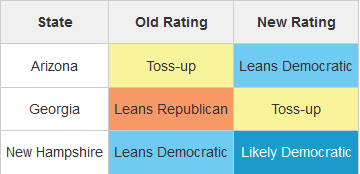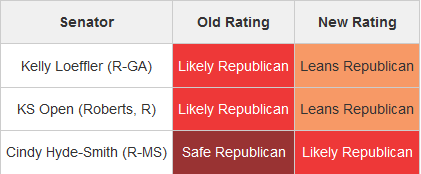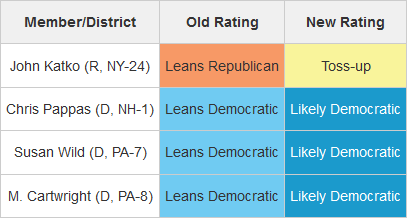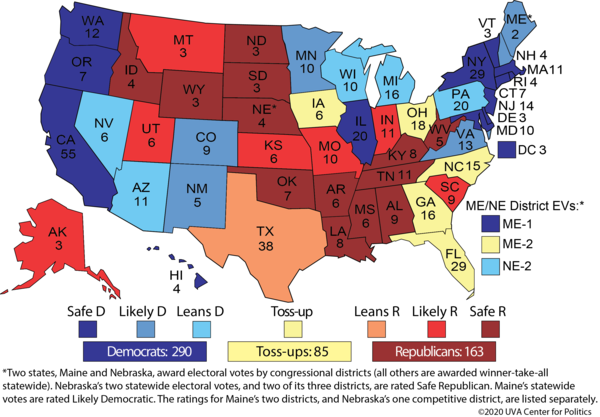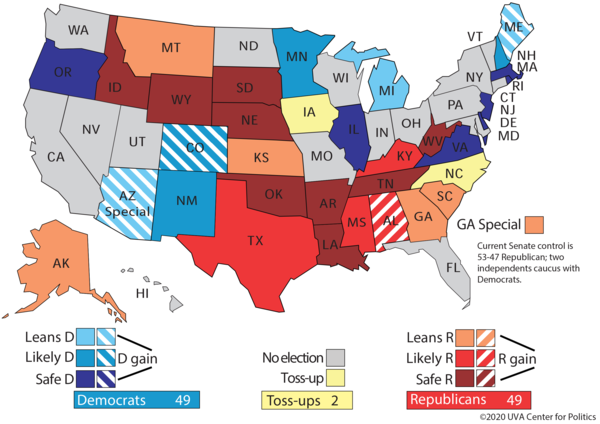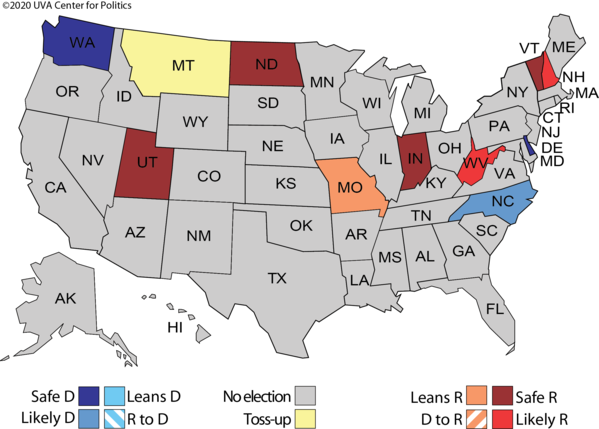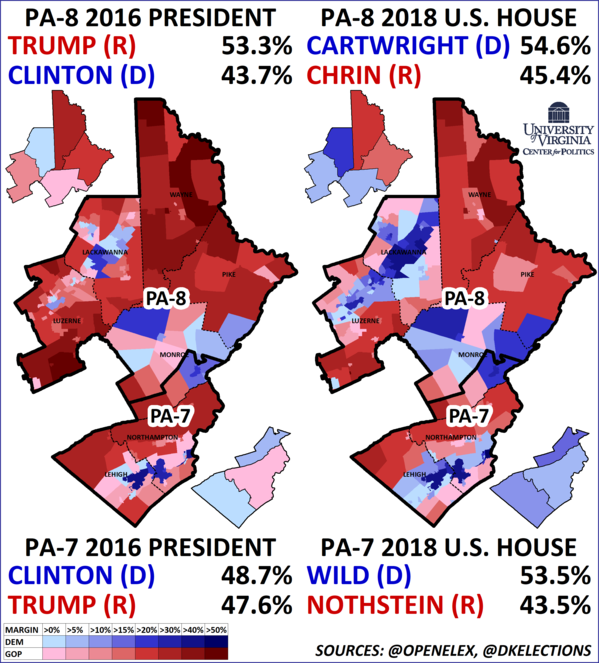With Just Weeks to Go, Trump is Not Making up Ground
A Commentary By Kyle Kondik and J. Miles Coleman
Rating changes in Electoral College, Senate, Governor, and House.
KEY POINTS FROM THIS ARTICLE
— Recent rosy polling for Joe Biden in the presidential race may represent an artificial sugar high for the challenger.
— But at this point, Donald Trump needs to be making up ground — not treading water or falling further behind.
— 11 rating changes across four categories of races (president, Senate, House, and governor) almost exclusively benefit Democrats.
Table 1: Crystal Ball Electoral College rating changes
Table 2: Crystal Ball Senate rating changes
Table 3: Crystal Ball gubernatorial rating change
Table 4: Crystal Ball House rating changes
The state of the presidential race
We could recap, at great length, all of the crazy events that have happened just in the week since we unveiled last week’s rating changes. But we suspect Crystal Ball readers don’t need any reminders.
Last week, we wrote that Donald Trump needed to help himself at last week’s debate more than Joe Biden did, because Trump is trailing and Biden is leading.
We did not think Trump did help himself, and the numbers we’ve seen since the debate have backed up that initial reaction. It also does not appear that the president and many top officials contracting coronavirus has made the president look better or improved his chances.
Ever since Trump took that ride down the Trump Tower escalator more than five years ago, a common question has been whether this episode or that episode would hurt his standing. In many instances, the answer has appeared to be no. But with just weeks to go until the election, asking whether something hurts Trump is the wrong question. Rather, the key question is whether something helps.
In recent days, Joe Biden’s significant lead nationally has widened. Biden’s leads in the RealClearPolitics and FiveThirtyEight polling averages are now close to 10 points apiece, and a couple of respected national polls, CNN/SSRS and NBC News/Wall Street Journal, have shown Biden leading by 16 and 14 points, respectively. The state-level numbers generally have been bad for the president, too: for instance, Monmouth University pegged Biden’s lead in Pennsylvania earlier this week at around 10 points; the pollster’s previous Keystone State survey had Biden up only a few points based on different turnout models. In other words, one of the better state-level polls for Trump in a key state was reversed in fresher polling.
At least some of the numbers we’re seeing for Biden now likely represent a sugar high for the challenger, which can happen sometimes when one candidate performs poorly or is on the wrong side of a bad story. Hillary Clinton’s national lead against Trump hit double digits in some polls following the revelation of the Access Hollywood recording in early October 2016, although Clinton’s aggregate lead over Trump in national polling as measured by RealClearPolitics hit only a high point of seven that October, and her share of the vote in the average never surpassed 49% in the fall (she ended up getting 48%).
Biden, meanwhile, has not dipped under 49% in RealClearPolitics since early August, and he was approaching 52% Wednesday evening.
To borrow a phrase from Biden, here’s the deal: The president needs the election to get closer to have a reasonable chance of once again pulling off an upset. That can still happen, but it is not happening now. The clock keeps ticking to Election Day, and voters are already voting.
Last week, we pushed some Midwestern state ratings in favor of Biden, citing his apparent gains with white voters. This week, we are moving another northern, largely white state, New Hampshire, in his favor.
The Granite State, so close in 2016, does not appear to be a major focus of the campaign, and the notoriously fickle state may be moving away from the president. Several recent polls of New Hampshire have shown Biden leading by roughly 10 points in aggregate — a shift that is similar to the kinds of improvements Biden appears to be making over Clinton’s showing across the competitive states of the Northeast and Midwest (Clinton only won New Hampshire by 0.4 points in 2016). New Hampshire is now Likely Democratic.
Of the states Clinton won, all are now rated Likely or Safe Democratic, with the exception of Nevada (Leans Democratic).
Beyond the Midwest, we now have seen enough to make two other shifts in the emerging battlegrounds of the Sun Belt: Arizona and Georgia. The former moves from Toss-up to Leans Democratic, and the latter from Leans Republican to Toss-up.
Biden’s lead in Arizona has been small but steady, generally in the neighborhood of 3-5 points in poll averages. His path to victory in the state almost certainly involves flipping Maricopa County (Phoenix) from red to blue. Maricopa, which casts about 60% of the state’s votes, was one of only a handful of the nation’s most populous counties to back Trump in 2016, but it seems primed to shift to Biden. One recent data point: the state pollster OH Predictive Insights released a poll Wednesday morning of AZ-6, a relatively affluent and highly-educated suburban district that covers Scottsdale and other parts of Greater Phoenix (AZ-6 is entirely contained within Maricopa). The district shifted from giving Mitt Romney a 21-point margin in 2012 to a 10-point margin for Trump, and Trump was only up one point in the poll.
This kind of erosion threatens the GOP’s statewide margin.
While Georgia and Arizona are a lot different — the former’s diversity is driven by Black voters, while the latter’s is driven by Hispanic voters — one commonality is that both states have a huge metro area where Biden seems poised to improve on Clinton. In Georgia’s case, that is metro Atlanta, with the suburban congressional districts GA-6 and GA-7 representing prime candidates to switch from Trump to Biden.
Metro Atlanta, however, doesn’t dominate the statewide vote the same way that metro Phoenix does: Fulton County (Atlanta) and its three biggest suburban/exurban satellite counties (Cobb, DeKalb, and Gwinnett) only cast about a third of the statewide vote, and Biden has to make up more ground statewide there than in Arizona (Trump won Arizona by 3.5 points and Georgia by 5.1 points). But Georgia is very close in polling, with Biden and Trump exchanging small leads. The state’s more of a Toss-up now.
These changes, shown in Map 1, push Biden a little further over 270 electoral votes while making Trump’s deficit a little bigger.
Map 1: Crystal Ball Electoral College ratings
The Senate
While we have rating changes in a trio of states, we’ll start with one race we’re not moving. In North Carolina — which we’d seen as arguably the Democrats’ best pickup opportunity, aside from the races that the Crystal Ball already has them favored in — the Democratic nominee, former state Sen. Cal Cunningham, was put on the defensive last week when text messages emerged indicating that he had engaged in an extramarital affair.
For now, we’re leaving the race as a Toss-up. A handful of polls conducted during and/or after the story emerged have not shown much difference from previous iterations of the same polls, and Cunningham generally still leads first-term Sen. Thom Tillis (R-NC). So this could be a case of the electorate being too polarized and/or too desensitized to care about a candidate’s personal scandals.
As of Friday, more than 300,000 early votes had already been cast in North Carolina, so both sides are starting to bank votes (for reference, in 2016, the state cast 4.7 million ballots).
Still, with the Army Reserve looking into this — Cunningham is a lieutenant colonel in the reserve — the situation seems fluid. Though the news doesn’t seem to have hampered Cunningham’s prospects yet, if it keeps escalating, at some point it may just become too much to sustain. Republicans are already working to make the story stick.
The revelations about Cunningham’s texts came on Friday evening — for state political observers, it was a development that concluded an already-eventful week in the race. On Thursday, before the two candidates squared off in their final debate, the Cunningham campaign announced it raised $28 million in the third quarter, shattering previous records. Then on Friday, Tillis announced he was diagnosed with COVID-19.
Ironically, after nominating women candidates exclusively in the four Senate races from 2008 to 2016, North Carolina Democrats are once again running a male candidate. After news of the texts broke, Cunningham was quickly compared to the state’s last male Democratic senator — John Edwards, whose electoral career was also rocked by an extramarital affair.
The bottom line in North Carolina is that we had been very tempted to move the race to Leans Democratic. The emergence of this scandal makes us glad we held off, as it is the sort of thing that could eventually undo Cunningham’s campaign (though it is not guaranteed to).
Staying in the South, we’re feeling less confident about Republicans’ chances in the special Senate election in Georgia. This election will be held under Louisiana-style jungle primary rules. Because the race features about 20 candidates, it’s unlikely that anyone will claim the majority needed to win outright in November, so a Jan. 5, 2021 runoff seems certain.
Some polls over the last few months pointed to an intraparty GOP runoff, featuring appointed Sen. Kelly Loeffler (R-GA) and Rep. Doug Collins (R, GA-9). But, with an endorsement from President Obama and by running a more active campaign, Democrats’ preferred candidate, the Rev. Raphael Warnock, seems better-positioned to at least land a spot in the runoff. Polling from Quinnipiac University puts Warnock ahead of the field, with 31% — more importantly, he claims almost 60% of the Black vote (Warnock is Black). We expect him to further consolidate that support.
Loeffler may have a slight edge for the second runoff berth, though she’s trying to get there by running to the right of Collins. This might be a good short-term strategy, but in a runoff, it may give her less room to win independents. Either way, we’re moving the race from Likely Republican to Leans Republican. The state’s regular Senate race, between Sen. David Perdue (R-GA) and 2017 GA-6 candidate Jon Ossoff (D), could also end up in a Jan. 5 runoff.
Another state we’re moving from Likely Republican to Leans Republican is Kansas. Republicans seemed to catch a break in the August primary when their voters nominated Rep. Roger Marshall (R, KS-1) over former Kansas Secretary of State Kris Kobach, a controversial Trump acolyte who lost the 2018 gubernatorial race. While Marshall may have been the safer pick, he hasn’t been able to put the race away. In polling from his allies, Marshall leads his opponent, state Sen. Barbara Bollier (D), 43%-39% — tellingly, his share is 10 percentage points less than the 53% Trump earns in the state.
Bollier, who was a Republican until 2018, seems to have a background tailor-made for Kansas’ suburban Johnson County, where she’ll need to win by double-digits. In her ads and on the campaign trail, she has pointed to her endorsements from some prominent state Republicans, most notably former Sen. Nancy Kassebaum (R-KS).
The Kansas race has recently attracted some significant investments from both sides. Last week, the Republican-aligned Senate Leadership Fund announced a $7 million buy there. Days later, the Democrats’ Senate Majority PAC pumped $7.5 million into the race. With this type of spending, it just doesn’t have the feel of a Likely Republican race anymore, even though a Democratic Senate win in Kansas would be a huge upset (Democrats have not won a Senate race there since 1932).
Finishing back up in the South, we’re moving Mississippi onto the board. The contest there features a rematch between Sen. Cindy Hyde-Smith (R) and former Rep. Mike Espy (D, MS-2), who served in President Clinton’s administration as Secretary of Agriculture. Though their 2018 contest went to a special runoff, which Hyde-Smith won by less than 8%, Espy’s margin represented Democrats’ best showing since 1988 in a Mississippi Senate race. Like many Democratic candidates, Espy’s campaign saw an influx of cash in the days following the death of the late Justice Ruth Bader Ginsburg. The anti-Trump Lincoln Project has also waded into the race.
Mississippi is a highly inelastic state: Blacks make up roughly 40% of the electorate and give Democrats near-unanimous support, while whites vote Republican with a similar intensity. But during his time in the House, Espy worked to build multi-racial coalitions, and seems to be taking a similar approach this year. We still see Hyde-Smith as a clear favorite, but we don’t think the seat is completely secure. We’re rating the race as Likely Republican now.
Overall, the battle for the Senate remains close, and Cunningham’s missteps in North Carolina could be crucial to the overall outcome. However, the playing field also appears to be expanding, and we now list six GOP-held seats in the Leans Republican column, in addition to three others where Democrats are at least narrowly favored (Arizona, Colorado, and Maine) and two that are Toss-ups (Iowa and North Carolina). Republicans remain on track to defeat Sen. Doug Jones (D-AL), and they are pushing Sen. Gary Peters (D-MI) in a race that is still Leans Democratic.
Republicans remain in the running to save their Senate majority, but there’s also a world in which the dam breaks against them.
Map 2: Crystal Ball Senate ratings
The Governors
In Vermont, two-term Gov. Phil Scott (R-VT) fits his deep blue state as well as any Republican can. One of the party’s most ideologically moderate members currently in office, Scott has received especially strong reviews for his handling of the COVID-19 pandemic. In September, Dr. Anthony Fauci, the nation’s top infectious disease expert, called Vermont’s response a “model” for the rest of the county.
Scott’s opponent is Lt. Gov. David Zuckerman — though he’s a member of the Vermont Progressive Party, he’s running with the support of state Democrats. A similar formula has worked out well for Sen. Bernie Sanders (I-VT), an independent who caucuses with Democrats. But with the COVID-19 pandemic still dominating the news cycle, it’s hard to defeat an incumbent governor, especially one who has earned bipartisan praise.
A poll released jointly by Vermont Public Radio and Vermont PBS gives Scott a 55%-24% lead. So Scott seems well-positioned to, again, transcend the state’s presidential partisanship. We’re upgrading his race to Safe Republican.
Elsewhere in New England, Democrats are hoping that they can push Gov. Chris Sununu (R-NH), who retains a big polling edge but who also may be easier to tie to national Republicans than Scott. That race remains Likely Republican.
We’re also keeping the gubernatorial race in Montana as a Toss-up — it’s the only Toss-up we have in the gubernatorial races this year. Republicans are trying to win this race for the first time since 2000, and there are some signs that their losing streak may end this year. In their June primary, Republicans passed over state Attorney General Tim Fox — who was the best-performing statewide Republican there in 2016 — for, arguably, a weaker candidate in Rep. Greg Gianforte (R, MT-AL). Still, Gianforte has led Lt. Gov. Mike Cooney (D-MT) in every poll that’s been released since July, about a handful in all.
The Democrats’ best offensive target appears to be Missouri, where Gov. Mike Parson (R) is trying to fend off a challenge from state Auditor Nicole Galloway (D). Parson appears to retain a lead of somewhere in the mid-single digits, but this is one to watch.
Overall, Missouri (Leans Republican) and Montana (Toss-up) appear to be the two races where the outcome is least certain. Trump seems very unlikely to replicate his roughly 20-point wins in each state, and he may lag significantly behind those kinds of margins. That said, Republicans probably are still better-positioned in each race, albeit not clearly enough in Montana to push the race out of Toss-up.
Democrats do appear to retain an edge in the marquee gubernatorial race of this cycle, North Carolina: Gov. Roy Cooper (D) consistently runs ahead of Biden in polls and still appears to be on track to win a second term, even if he likely will win by a smaller margin than some polls earlier this year suggested. In other words, do not expect a double-digit Cooper victory even as we remain confident enough in his chances to keep his race at Likely Democratic.
Map 3: Crystal Ball gubernatorial ratings
The House
We have just a handful of House rating changes this week, all benefiting Democrats.
Three of the four changes upgrade Reps. Chris Pappas (D, NH-1), Susan Wild (D, PA-7), and Matt Cartwright (D, PA-8) from Leans Democratic to Likely Democratic. While all three have competent GOP challengers, key Republican outside groups do not appear likely to spend big outside dollars in any of the three races, which indicates to us that the incumbents are in decent shape for the stretch run.
The two Pennsylvania seats merit special mention. Map 4 shows how the two Democratic House members performed in 2018 versus the 2016 presidential results. As the map makes clear, the president performed well in both, but Democrats did well the following cycle (these district lines were drawn in advance of the 2018 election).
Map 4: Recent results in PA-7/PA-8
Morning Call/Muhlenberg College showed Wild up 52%-39% in her race recently, with Biden up by seven. While there is no public polling of the neighboring and Trumpier PA-8, our understanding is that Cartwright is doing well, and Biden could even do well enough to flip the district, which covers his boyhood home of Scranton. In a sign of confidence, the Democratic Congressional Campaign Committee recently cut ad spending in the district. These are the kinds of districts where Trump needs to perform well — arguably, even better than he performed in 2016 — to once again win Pennsylvania, and that Republicans really need to compete for in order to win a House majority. But the region may not be as hospitable to Trump as it was four years ago.
Moving north from eastern Pennsylvania to upstate New York, Rep. John Katko (R, NY-24) appears to be in an increasingly competitive race against former college professor Dana Balter (D). Katko beat Balter by six points in 2018, making him one of the few Clinton-district Republicans to survive the Blue Wave. For much of the cycle, we thought Katko would be fine, but an increasing amount of outside spending has prompted us to reconsider. So too has a Siena College poll that showed Balter up 45%-42%. This race moves from Leans Republican to Toss-up.
Our overall House outlook — Democrats are better-positioned than Republicans to net seats — remains unchanged.
Kyle Kondik is a Political Analyst at the Center for Politics at the University of Virginia and the Managing Editor of Sabato's Crystal Ball.
J. Miles Coleman is an elections analyst for Decision Desk HQ and a political cartographer. Follow him on Twitter @jmilescoleman.
See Other Political Commentary by Kyle Kondik.
See Other Political Commentary by J. Miles Coleman.
See Other Political Commentary.
This article is reprinted from Sabato's Crystal Ball.
Views expressed in this column are those of the author, not those of Rasmussen Reports. Comments about this content should be directed to the author or syndicate.
Rasmussen Reports is a media company specializing in the collection, publication and distribution of public opinion information.
We conduct public opinion polls on a variety of topics to inform our audience on events in the news and other topics of interest. To ensure editorial control and independence, we pay for the polls ourselves and generate revenue through the sale of subscriptions, sponsorships, and advertising. Nightly polling on politics, business and lifestyle topics provides the content to update the Rasmussen Reports web site many times each day. If it's in the news, it's in our polls. Additionally, the data drives a daily update newsletter and various media outlets across the country.
Some information, including the Rasmussen Reports daily Presidential Tracking Poll and commentaries are available for free to the general public. Subscriptions are available for $4.95 a month or 34.95 a year that provide subscribers with exclusive access to more than 20 stories per week on upcoming elections, consumer confidence, and issues that affect us all. For those who are really into the numbers, Platinum Members can review demographic crosstabs and a full history of our data.
To learn more about our methodology, click here.
